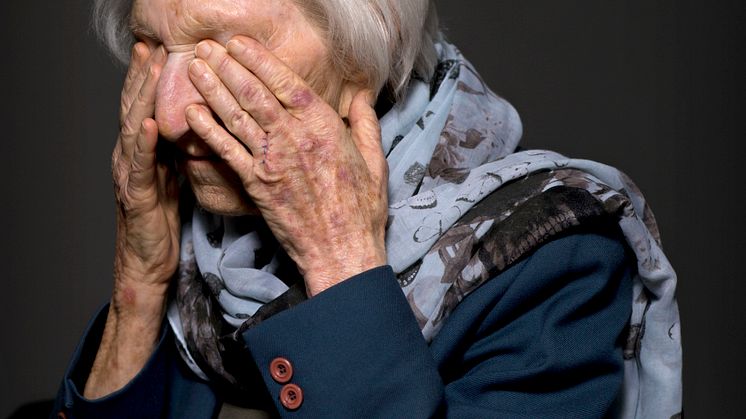
Press release -
Hédi Fried is this year’s Portrait of Honour
On Saturday 13 June, the 2015 Portrait of Honour will be unveiled at Gripsholm Castle. The subject this year is Hédi Fried, the writer and psychologist, as portrayed by the photographer Sanna Sjöswärd. It is a subtle, insightful portrait of one of the last living Holocaust survivors.
Hédi Fried was born on 15 June 1924 in Sighet, northern Transylvania, which was part of Hungary at the time but is now in Romania. She trained as a teacher and as a psychologist, and obtained a degree in philosophy in 1980, but is known to the public mainly as a writer. In several of her books, including Fragments of a Life (1992) and Back to Life (1995), she describes the horrors of the Holocaust, her life after these traumatic experiences, her childhood, and her thoughts on the future. Having survived Auschwitz and Bergen-Belsen, Fried arrived in Sweden in July 1945. In recognition of her distinguished service to humanitarian causes, the Swedish government awarded Fried the Illis Quorum medal in 1998. The following year she received the European of the Year award, and in 2002 an honorary doctorate from Stockholm University.
Fried has taken upon herself the important but painful task of bearing witness to the evils of Nazism. She has done so through her books and through presentations to schools since 1984. Memory plays a key role in Fried’s message to those of us living today. The issue has stark moral implications: “If we do not remember, then it [the Holocaust] never happened, and they [those killed] never lived.” This is the reason why Fried took it upon herself to play the role of witness and memory keeper for posterity, which was no easy task. “We would prefer not to remember; we would rather keep the pain at bay.” Needless to say, Fried is speaking here from personal experience, just as she is when she writes that “as long as we are afraid of our memories and keep them locked away, they will behave like our enemies.” In order to bear witness, she has had to “befriend” the nightmares she seeks to describe. If those who experienced the full evil of the Holocaust choose to use their powers of selective recall, how are we to pass on those memories to future generations? Fried addresses this question in her 2003 book Livets pendel [Pendulum of Life].
Hédi Fried is one of the few people still alive who remember the horrors of Auschwitz. How can a portrait capture this, which it is so hard for us to comprehend today? In a subtle manner, photographer Sanna Sjöswärd has successfully interpreted something we can never properly put into words in her portrait of Fried. This may have something to do with Sjöswärd’s own background as an adoptee from Iran, where she was born Farzaneh Doranian in 1973. Today, she has a successful career as a documentary and portrait photographer. In the latter genre, she often creates close-ups – both in the physical sense and in her intimate portrayal of the subject. The photographer’s close engagement with her subjects permeates the portraits. Strong individuals are a recurring theme. For her 2011 book Eldsjälar [Driving Forces], Sjöswärd photographed and interviewed 30 people actively engaged in various humanitarian or artistic causes, including Hédi Fried.
Sjöswärd’s portrayals are never simple, but present a complex image of the subjects and the environment they inhabit. The homelessness of Ninni (2004) and the eating disorder of Engla Louise (2009) are not the only aspect of their existence. Sjöswärd’s aim is for the onlooker to see the whole person. Sjöswärd came to the attention of a wider audience in 2006 with an exhibition and accompanying book titled Rötter/Roots, depicting her encounters with her mother, her siblings and their families in Iran. Her 2009 autobiography Min mamma är en persisk prinsessa [My Mum Is a Persian Princess] deals with the same subject matter. In 2012, Sjöswärd received Sweden’s Photographer of the Year award and the K.W. Gullers Scholarship. The Swedish National Portrait Gallery already includes several of her works, including the Portrait of Honour of Theodor Kallifatides.
Press coverage
The portrait will be unveiled at the Gripsholm Castle Association’s annual meeting, starting at 10:30 am on Saturday 13 June at Gripsholm Castle. Hédi Fried and Sanna Sjöswärd will both be present. Media representatives wishing to attend must register in advance with Timmy Cox, First Supervisor Gripsholm Castle, The Royal Court:timmy.cox@royalcourt.se, +46 8 402 8570
Press contact
Hanna Tottmar, Press Officer, Nationalmuseum
hanna.tottmar@nationalmuseum.se, +46 767 234632
Caption
© Sanna Sjöswärd, Hédi Fried.
The Swedish National Portrait Gallery at Gripsholm Castle, the world’s oldest national portrait gallery, was founded in 1822 and is managed by Nationalmuseum. A number of works are added to the collection each year, including an annual Portrait of Honour, donated by Gripsholmsföreningen, depicting a distinguished Swedish citizen.
Categories
Nationalmuseum is Sweden’s premier museum of art and design. The collections comprise older paintings, sculpture, drawings and graphic art, and applied art and design up to the present day. The museum building is currently under renovation and scheduled to open again in 2018. In the meantime, the museum will continue its activities through collaborations both in Sweden and abroad as well as temporary exhibitions at the Royal Swedish Academy of Fine Arts, Fredsgatan 12 and Nationalmuseum Design at Kulturhuset Stadsteatern in Stockholm. Nationalmuseum collaborates with Svenska Dagbladet, FCB Fältman & Malmén and Grand Hôtel Stockholm. For more information visit www.nationalmuseum.se.

